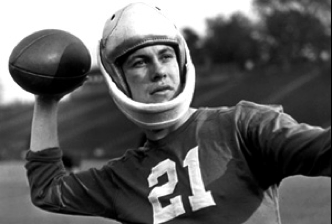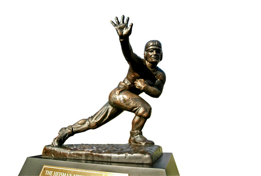(College Football Hall of Fame Inductee)

In 1954, every major highway leading into the City of Youngstown had a sign at the city limits announcing “Home of Frank Sinkwich.” The signs are gone now, but Frank Sinkwich’s football fame still exists at the University of Georgia and in the hearts of old sports fans from Chaney High School.
Francis “Frankie” Sinkwich was born in the Pittsburgh suburb of McKees Rocks, Pennsylvania, to immigrant parents from Russia. When he was still a child, his family relocated to the west side of Youngstown, Ohio. Sinkwich gained early recognition as a star athlete at Youngstown's Chaney High School. In 1939, he was recruited by the University of Georgia and that fall Sinkwich made headlines playing for the "Point-a-Minute Bullpups," the university's freshman football squad.
After having his jaw broken early in 1941 season, he played the remaining regular season games with his jaw wired shut and a large jaw protector attached to his helmet (an innovation preceding the first face masks). He wore the protector when he led Georgia to a 40-26 victory over Texas Christian University at the 1942 Orange Bowl.
Sinkwich was known for his toughness and not for his size. He stood only 5 feet 10 inches and weighed 185 pounds. He was a two-time All-America selection and led the “Georgia Bulldogs” to an 11-1 season in 1942, capturing the Southeastern Conference Championship and a victory over UCLA in the 1943 Rose Bowl. (He played that game with sprained ankles.) That same season, the Washington, D.C. Touchdown Club honored Sinkwich as "back of the year", and he was overwhelmingly voted the Number 1 athlete for 1942 in the annual poll by the Associated Press over second-place finisher Ted Williams of the Boston Red Sox, a year in which Williams was American League Batting Champion, American League Home Run Champion and hit for baseball's triple crown. Frank beat out Williams by a vote of 94 to 55. For his stellar play in 1942, which included a still-unbeaten school record of twenty-seven touchdowns, Sinkwich was awarded the Heisman Trophy by a unanimous vote. The University of Georgia has since honored him by retiring his jersey, number 21.
In 1943, the Detroit Lions, a professional football team, drafted him in the first round. In his two years as a running back with the Lions, Sinkwich was named All-Pro twice and the league’s MVP in 1944. The following year he was accepted into the Air Force. Soon after, he suffered a serious knee injury playing for the Air Force football team. This injury ended Sinkwich's career at the age of twenty-five. After the setback he coached at Furman University in Greenville, South Carolina, and the University of Tampa, Florida, before settling in Athens, Georgia, as a businessman. In 1954, he was inducted into the College Football Hall of Fame now located in South Bend, Indiana. When you visit the Football Hall of Fame, you will learn that in his three-year college career, Sinkwich rushed for 2,271 yards, passed for 2,331 yards, and accounted for 60 touchdowns – 30 rushing and 30 passing.
Because the United States was at war and metals were scarce, Frankie only received a paper certificate instead of the Heisman Trophy. It was much later that he was awarded his metal statue, which is on display at the University of Georgia.

